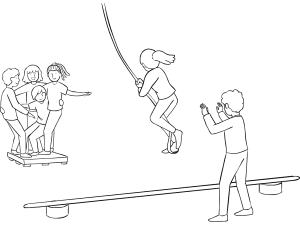Spotting is a term used to describe an activity that aims to secure and protect the physical well-being of a person engaged in an activity. In practice, it may look like breaking or catching a person’s fall, but it may also be as simple as being alert for potentially harmful events or objects.
As a program develops, the momentum to assume bigger challenges – that is, greater perceived and actual risks – often increases. This may attract an individual or group to assume some more physically demanding and harmful activities.
Naturally, as program leaders, were are called to facilitate a safe outcome on these occasions, but there is enormous value in empowering our groups to partner this responsibility. And this is where spotting skills come in.
Essential Spotting Skills Tips
Spotting is perhaps one of the most difficult tasks to teach because, in most cases, people do not recognise the importance of being a spotter until it’s too late, ie someone falls or is hurt. It’s a bit like shutting the gate after the horse has bolted.
No matter your approach, here are some key points to remember when teaching effective spotting skills to your group:
- A safe spotting stance will require the spotter to be balanced with one foot in front of the other, knees flexed to absorb impact, eyes forward and their hands up in a ready position.
- Introduce a carefully planned sequence of activities to help your group practice their spotting skills.
- When ready, a series of common safety or check-in protocols/commands are recommended to prepare everybody before action. This communication is critical because it means that both the participant and the spotters share responsibility for a good outcome. A typical check-in protocol may sound like this:
“ARE MY SPOTTERS READY?”
“READY.”
“I’M READY TO… [WALK, RUN, FALL, etc]”
“[WALK, RUN, FALL, etc] AWAY.”
- Spotters will follow and mimic the movements of the participant at all times and remain with them until the activity concludes, ie they have stepped off the activity.
- Spotting should focus on ‘breaking’ or supporting a fall, not catching a person. Even if both people end up on the ground, the spotter has performed their role responsibly.
- The spotter’s eyes must focus on the participant at all times.
- Protecting or supporting the head, neck and upper torso of the participant is the highest priority for a spotter.
- Spotting should not be confused with helping or assisting the participant to complete their task.
- The spotter’s position relative to the participant will vary depending on the type of element, eg traversing, swinging, balancing, etc.








